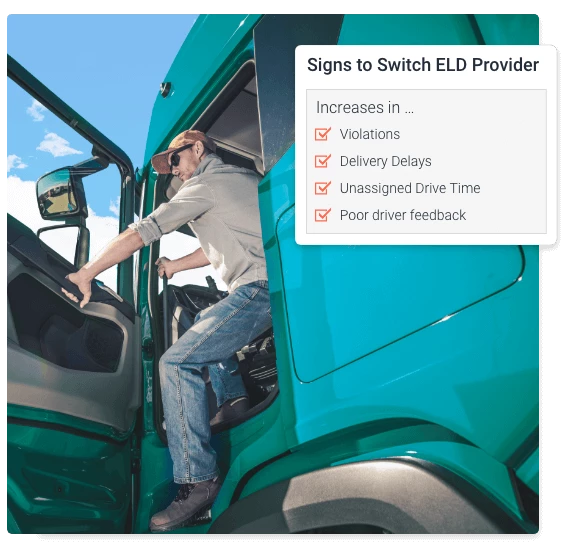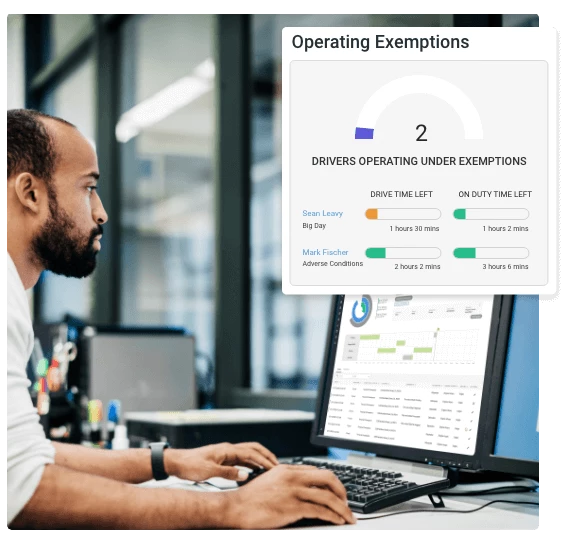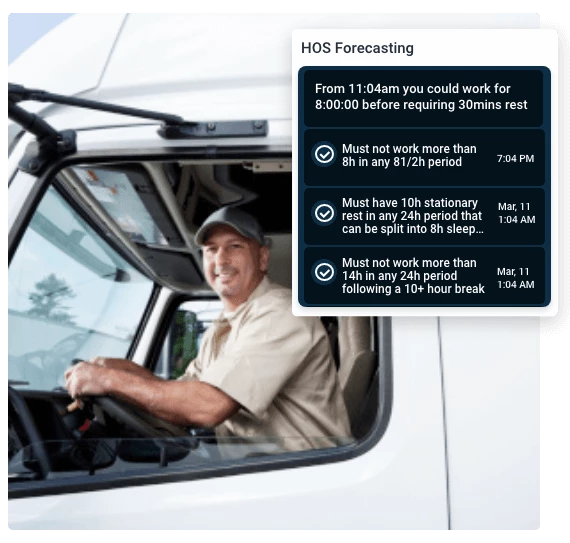Key Takeaways
Electronic logging devices, also known as ELDs, have become a critical tool for trucking and transportation companies required to track hours of service (HOS). However, as businesses and their requirements change many fleet operators will need to switch ELD providers to help them comply with the regulations. In this guide, we’ll cover everything you need to know about finding a new ELD solution for your business, including legal requirements, criteria for selecting an ELD provider and step-by-step instructions for making the switch.
Table of Contents
1. When to Switch ELD Providers
2. The Benefits of Using the Best ELD Solution for your Business
3. What to Look for in an Electronic Logging Device
4. Step-By-Step Instructions for Switching ELD Providers
5. Questions to Ask an ELD Fleet Management Software Provider
6. Meet All of your ELD and Fleet Management Needs
When To Switch ELD Providers
As an essential tool for compliance and efficient fleet management, it’s important that your ELD is a good fit for your business. However, not all ELD providers are created equal, and there may come a time when changing providers becomes necessary. Here are some of the main reasons you may need to consider a new ELD solution.
- Increases in violations. If your fleet starts experiencing a significant increase in compliance violations, like logbook errors or HOS violations, it may be an indication your current provider is not delivering accurate and reliable data. These compliance issues can result in penalties, audits and reputational damage that can affect the long-term health of your business.
- Increased delivery delays. Delayed deliveries result in dissatisfied customers and poor operational efficiency. A recurring pattern of delayed deliveries could be a sign that your current ELD solution isn’t providing the insight needed to effectively plan driver schedules. Switching to a better ELD provider with real-time visibility into driver available hours can prevent delays and increase customer satisfaction.
- Significant unassigned drive time. Unassigned drive time can be the result of technical glitches or limited ELD functionality. In either case, it can skew your recordkeeping and lead to poor operational performance. If your ELD provider struggles to assign drive time correctly, it may be time to upgrade to a more powerful solution.
- Poor driver feedback. Your drivers are a valuable source of information regarding the effectiveness of your ELD solution. If your team is consistently expressing frustration with usability, reliability or functionality, it’s important to address their concerns to prevent unnecessary compliance issues or driver turnover. Engage with your drivers to learn their pain points and consider their feedback when shopping for ELD providers.

The Benefits of Using the Best ELD Solution for your Business
Electronic logging devices offer numerous benefits for fleets and drivers. Some of the primary benefits of an effective ELD solution include:
- Improved safety. By tracking hours and preventing driver fatigue, ELDs can help reduce the risk of accidents. Devices can also send drivers alerts as they approach their limits, making it easier to take breaks to avoid dangerous driving. ELDs are one of the reasons why 91% of businesses saw reduced accidents when adopting telematics.
- Increased efficiency. ELDs can help fleets increase their efficiency by streamlining processes and reducing administrative overhead. With automatic recordkeeping, ELDs can save time and reduce errors.
- More effective management. Logging devices can provide fleet managers with real-time visibility into their operations, allowing them to track driver performance, monitor compliance and identify areas for improvement. Accurate data can also help incentivize effective performance, and 96% of businesses use this information to create reward programs for their employees.
- Improved driver experience. ELDs can reduce paperwork for drivers. In addition to automatic recordkeeping, ELD fleet management software can digitize processes like driver vehicle inspection reports (DVIRs) and similar tasks. These solutions can also store all data in a centralized location for easy access.
These benefits can translate into significant cost savings for a business. Fleets save money by reducing the risk of fines and violations, improving fuel efficiency and optimizing routes and schedules. By choosing the right ELD provider and system, fleets can maximize these benefits and improve their operations and profitability.
What To Look for in an Electronic Logging Device
When adding a new electronic logging device to your fleet, there are a variety of key factors to consider. An ELD is more than just a tool for tracking hours of service. Your device needs to be capable of ensuring compliance, improving operational efficiency and enhancing overall fleet management. Here are the most important aspects to consider when shopping for an ELD.
Full Compliance with Regulatory Requirements
Compliance is one of the most important factors to consider when selecting an ELD provider. The FMCSA has established strict requirements for ELDs to ensure that they accurately record a driver’s HOS and comply with safety regulations. Failure to comply with FMCSA regulations can result in fines, penalties or even the revocation of operating authorization. For this reason, it is essential to carefully evaluate potential ELD providers to ensure that their devices are compliant with FMCSA ELD requirements.
ELD providers should also be able to provide documentation to prove that their devices are compliant with FMCSA regulations. This documentation should include a certificate of compliance, a letter of self-certification or a listing on the FMCSA website.
Driver Hours Visibility
One of the primary purposes of an ELD is to track driver hours of service. Look for an ELD solution that offers comprehensive insights into driver hours. Dispatchers should have access to this dashboard, allowing them to monitor driver availability and plan assignments more efficiently.
Additionally, advanced driver notification features can be a valuable way to alert drivers and dispatchers when HOS limits are approaching or violations are imminent. This visibility into driver hours helps promote compliance and enables proactive management of resources.
DVIR Integration
Driver Vehicle Inspection Reports (DVIRs) are essential for ensuring safety and compliance. An effective ELD should integrate seamlessly with the DVIR process. Verify that the ELD application supports the recording of DVIRs and automatically captures the time spent on conducting inspections as on-duty time. This integration streamlines the inspection process, eliminates paperwork and ensures accurate reporting of on-duty hours associated with vehicle inspections.
Usability and Support
An ELD needs to be user-friendly and intuitive for drivers to operate effectively. Look for a solution with simple interfaces, easy navigation and clear instructions. A well-designed ELD can minimize the amount of time necessary to train drivers in addition to reducing the likelihood of user errors while using the system.
While usability is important, an ELD provider also needs to offer effective customer support and training for drivers and management teams. This ensures the effective use of the solution by all parties.
Full Integration Within a Fleet Management Application
While compliance is essential, a premium ELD solution can offer additional value far beyond basic logging capabilities. From reducing fuel costs and carbon footprint to giving you an edge over competitors the right ELD solution can fully integrate with a comprehensive fleet management platform to provide a broader range of features and benefits.
Data can be a powerful tool for your organization, but only if it’s actionable. By opting for an ELD that is part of a comprehensive fleet management platform, you can centralize your operations, streamline processes and gain deeper insights into your fleet's performance. Consider a customizable solution that allows you to turn data into decisions and move your business forward with certainty.

Step-by-Step Instructions for Switching ELD Providers
Businesses may choose to switch ELD providers for a variety of reasons. They may be looking for additional functionality, they may have outgrown their current provider’s capabilities, or they simply may have found a better ELD solution for their operation.
No matter the reason for changing ELD providers, here are some helpful steps to consider:
- Evaluate your current provider. Before switching, be sure you understand your current provider’s strengths and weaknesses. This will help you identify missing or insufficient features in your current ELD compliance software and what you’d like to see in a new provider.
- Research new providers. There are many ELD providers on the market, so it is crucial to research and compare options to find an ELD solution that fits your needs.
- Notify your current provider. Once you have identified a new provider, notify your current provider of your intent to switch. Review your contract to ensure compliance with any contractual obligations or cancellation requirements.
- Plan a transition period. Develop a clear plan outlining the transition process. Communicate this plan to all relevant stakeholders, such as operators, management and support teams.
- Identify and train a pilot group. Identify and train a small group of operators or a specific region to serve as a pilot for the new ELD solution. This group should be representative of the overall operator population and willing to participate in the parallel testing phase.
- Install and test new ELD devices for the pilot group. Run parallel operations with the new and old solutions in the pilot group. This parallel period enables a side-by-side comparison to identify any issues, discrepancies or areas of improvement in the new system.
- Gather feedback and address issues. Regularly collect feedback from the pilot group regarding their experience with the new ELD solution. Encourage them to report any difficulties, bugs or concerns they encounter. Address these issues promptly and communicate the resolutions to the pilot group.
- Evaluate results and adjust as needed. Analyze the feedback, performance metrics and overall experience gathered from the parallel operations. Based on the results, make any necessary adjustments or enhancements to the new ELD solution before transitioning all operators to it.
- Gradually roll out the new system. Once the new ELD solution has been thoroughly tested and validated during the parallel period, gradually roll it out to the remaining operators. Consider implementing the transition in phases, allowing for training and support at each stage.
- Make full use of data gathered. Once devices are fully installed, continue to actively manage your system to look for ways to improve operations. Work with your new provider to ensure a full understanding of your new ELD products. This will help minimize disruptions and downtime while ensuring that your system is used to its full potential.

Questions to Ask an ELD Fleet Management Software Provider
When evaluating potential ELD providers, it is important to ask questions that will help you understand their capabilities and how they can meet your needs. Here are some additional details on the questions to ask an ELD provider.
Are you a registered ELD provider on the FMCSA website?
The simplest way to ensure a provider is compliant with FMCSA ELD requirements is to review the agency’s website. Providers and products listed on the FMCSA website have been tested and certified by the agency.
What features does your ELD system offer?
ELD systems can vary significantly in their features and capabilities, so finding the best fit for your business is necessary. In addition to essential ELD functions, many providers offer products with real-time tracking, maintenance scheduling and advanced reporting capabilities. By understanding the features available, you can ensure that you choose a provider that meets your specific needs.
How does your application manage exemptions and unassigned drive time?
An ELD system needs to efficiently manage exemptions and unassigned drive time through features like driver exemption monitoring and unassigned drive time reporting and allocation workflows. Fleet managers should also be able to easily make log edit suggestions to drivers to ensure accurate reporting and compliance.
Does your DVIR integrate with the ELD solution?
A DVIR is a vital aspect of any fleet. A premium ELD solution should seamlessly integrate with DVIR functionality to eliminate the need for separate systems. Additionally, an effective ELD solution can simplify inspections with features such as automatic recordkeeping and easy-to-use tools.
Can you provide references or case studies from existing customers?
Asking for references or case studies from existing customers can help you understand how the provider’s system has worked for other fleets. It can give you insights into the provider’s customer service and support, the reliability of their system, and how their system has helped other fleets improve their operations.
What support and training options are available?
Understanding the support and training options that are available can help you ensure that your drivers and management team are properly trained and can use the system effectively. Some providers may also offer online training or on-demand support to help you troubleshoot issues or answer questions. By understanding the level of support and training that is available, you can ensure that your team can use the system effectively.
How do you handle maintenance and updates to the ELD system?
Understanding how the provider handles maintenance and updates to the system is essential to ensuring that the system remains up-to-date and reliable. You should ask about how often updates are released, how they are installed, and how the provider handles any issues that arise after updates are installed.
Meet All of Your ELD and Fleet Management Needs
With 39% of businesses planning to invest in technology to help with compliance over the next 12 months, choosing the right ELD provider is crucial. Teletrac Navman's ELD solution offers an excellent solution for businesses looking to switch providers or adopt ELDs for the first time.
No matter the size of your fleet, the platform can be tailored to your specific needs. Whether you're running a large-scale mixed fleet operation or a small business fleet, AI-powered telematics can help you optimize your fleet's performance. You can build your custom solution on our website in just 30 seconds. If you have any further questions, our team of experts is available to assist you. Contact us today to learn more about TN360's capabilities and how it can benefit your fleet management needs.

